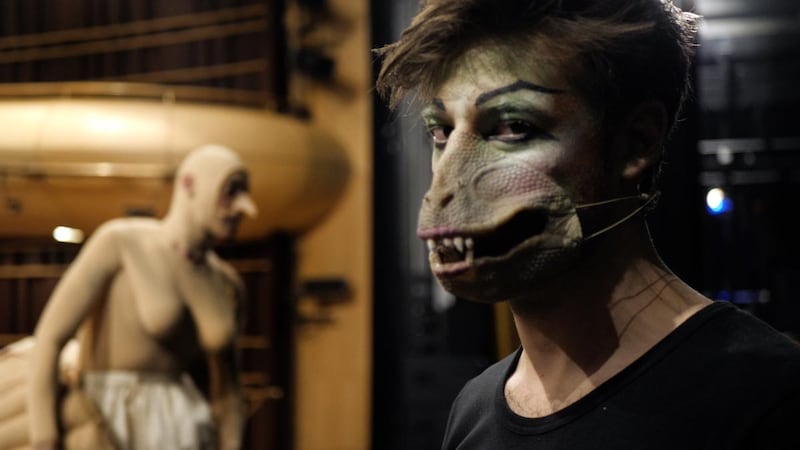Rehearsing in Athens, on the brink of bringing his latest production to Paris in 2020, the Greek choreographer Euripides Laskaridis learned that the performance was cancelled because of Covid. In response he created a film, Here Not Here, documenting those final preparations. If the cancellation was the problem, then this film is the solution, he claims.
Except it's not. The dance films and documentaries that featured throughout the second week of Dublin Dance Festival are no solution to the disappearance of live performance. Rather they are snapshots – maybe future important historical documents – of how a genre that relies on liveness and kinaesthetic empathy to the moving body managed to reimagine itself in response to physical isolation.
Here Not Here ★★☆☆☆ nonetheless offered behind-the-scenes access to some of the madcap theatricality of Laskaridis's work, complete with animal masks and outsize costumes, but felt like a stop-gap back-stage tour rather than meaningful documentation.
That honour fell to Dancing at Dusk: A Moment with Pina Bausch's The Rite of Spring ★★★★★. Never has a title undersold so much. The "moment" was a full performance of the 1974 classic on the beach of Toubab Dialaw, in Senegal.
Long restricted to her own company, Pina Bausch's works are now being performed by international companies, an effort by the Pina Bausch Foundation to disseminate her work more widely 12 years after her death. In 2020 they brought together 38 dancers from 14 African countries to re-create The Rite of Spring, but Europe locked down right at the end of the rehearsal period. With performances cancelled, the rehearsal directors and dancers staged a final run-through, filmed by Florian Heinzen-Ziob, under slowly fading crepuscular light. The low-tech surroundings and ad-hoc filming gave the performance added intensity, fuelled by the possibility of a last opportunity for this cast to dance together as the production faced an unknown future.
Alongside works created on the brink of lockdown, this year's festival, the last from Benjamin Perchet, continued to highlight the highly politically charged space that is the human body. For some of these, the festival took the initiative in commissioning dance films that were developed from existing stage works.
Ginevra Panzetti and Enrico Ticconi's Silver Veiled ★★★☆☆ was based on material from the diptych AeReA and ARA! ARA!, which investigated the power of a flag as a symbol of identity and oppression. Choosing dark symbolism rather than colourful vexillology, the flag doubled as a shroud and armour in the monochrome setting. Movement vocabulary was minimal as Panzetti and Ticconi slowly moved down half-enclosed corridors at the side of a courtyard or twirled flags in unison, like quickened semaphore. Eschewing rhetoric, the choreographers were content to let the simply presented images coalesce into a wider questioning of constructed identities.

Farmer Train Swirl: Étude (club version) ★★☆☆☆ was a short film of the Belgian choreographer Cassiel Gaube's two-year investigation into house dance. There was little opportunity to witness how he has inhabited these forms and imagined a new vocabulary, as the impressionistic camerawork sought to conceal as much as reveal Gaube's dancing body.
Ali Cahrour's The Love Behind My Eyes ★★★★☆ also used the camera lens to focus on small details of the moving body but guided the eyes to exactly the apposite image. Set in a small natural harbour at night time, the film reveals a slow-paced exploration of forbidden love between men under the watchful eyes of religion, politics and convention. The film opens with a woman, like a mother figure, singing on a boat as it approaches the harbour, while on shore two men await, one sitting sideways head in hand and another standing leaning back and swaying his chest skywards. The unfolding dance from Chahrour and Chadi Aoun is beautifully realised, oozing meditative tenderness but also pain, like the slow scrape of skin against a concrete floor or fingers clawing at eye sockets.
The three short films from Eric Minh Cuong Castaing's Form(s) of Life ★★★☆☆ saw dancers teaming up with people with muscular and motor deficiencies and acting as living protheses. Kamel Messelleka, a former professional boxer, stares down the camera and puts together combinations of hooks, jabs and uppercuts, his arms moved by two dancers over his shoulder. Eyes downcast in concentration, they are intently focused on Messelleka's body, reacting to his shifting weight, balance and strength needed behind each punch. Elise Argaud was a professional dancer, and her solo focuses on balance as she is supported from behind by a dancer who gently helps her slowly sway and swoop. Although the focus is on allowing these bodies to move and challenging how they are normally viewed in society, compulsive dance is also created.
St Patrick's Cathedral in Dublin was the setting for Justine Doswell's Dyad ★★★★☆, beautifully lit by Paul Keogan. Originally conceived as a live performance, it was filmed by the frequent dance collaborator Luca Truffarelli, whose camera offers different perspectives of the duet excellently danced by Salma Ataya and Justine Cooper. Based on the similarities and links between Mary and Maryam in the Christian and Muslim faiths, the two dancers have similar emotional and physical trajectories yet perform individual dances. Early drafts were based on Bach's contrapuntal writing in The Art of the Fugue, and a similar sense of individual journeys that coincide in moments of dissonance and confluence is evident in the dancers' movements.
Mary Barnecutt's score sensitively underpins the action, and adds slowly growing impetus, but is also content to quieten to birdsong or silence in sympathy with the action. Dyad has a sense of timelessness, yet the presence of facemasks on the performers places it, and much of the other work presented at this year's Dublin Dance Festival, at this singular moment in time.










